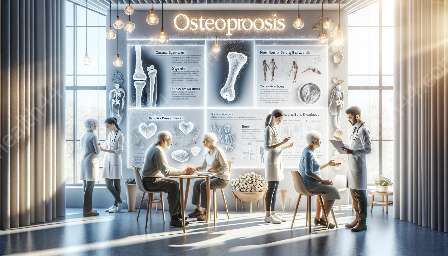Osteoporosis is a condition characterized by reduced bone density and quality, leading to an increased risk of fractures. This topic cluster will explore the pathophysiology of osteoporosis, including its impact on bone health and its relationship to other health conditions.
Overview of Osteoporosis
Osteoporosis is a systemic skeletal disorder in which bone density and bone quality are reduced, leading to an increased risk of fractures. It is a common condition, particularly among older adults, and can have significant impacts on an individual's quality of life. Understanding the pathophysiology of osteoporosis is essential for developing effective prevention and treatment strategies.
Pathophysiological Mechanisms
Osteoporosis develops as a result of an imbalance in the processes responsible for bone formation and bone resorption. Osteoblasts are responsible for bone formation, while osteoclasts are involved in bone resorption. In individuals with osteoporosis, there is an increase in bone resorption, leading to a net loss of bone mass over time.
This imbalance can be influenced by a variety of factors, including hormonal changes, nutritional deficiencies, and genetic predisposition. Estrogen deficiency, particularly in postmenopausal women, can lead to accelerated bone resorption and an increased risk of osteoporosis. Additionally, inadequate calcium and vitamin D intake can impair bone formation, further contributing to the pathophysiology of osteoporosis.
Impact on Bone Health
The pathophysiology of osteoporosis has significant implications for bone health. As bone density and quality decline, the risk of fractures increases. Fractures associated with osteoporosis commonly occur in the hip, spine, and wrist, and can have serious consequences, including chronic pain, disability, and reduced mobility.
Furthermore, the impact of osteoporosis extends beyond the skeletal system. Fractures associated with osteoporosis can have systemic effects, leading to increased morbidity and mortality, particularly in older adults. Understanding the pathophysiology of osteoporosis is critical for identifying individuals at risk and implementing interventions to prevent fractures and associated complications.
Relationship to Other Health Conditions
Osteoporosis is not an isolated condition, and its pathophysiology is interconnected with other health conditions. For example, individuals with osteoporosis may have an increased risk of falls due to impaired balance and muscle weakness, further predisposing them to fractures. Additionally, the impact of osteoporosis on bone health can exacerbate other health conditions, such as chronic pain, immobility, and decreased quality of life.
Furthermore, certain health conditions and medications may contribute to the pathophysiology of osteoporosis. For instance, long-term use of corticosteroids can lead to accelerated bone resorption and an increased risk of osteoporosis. Understanding the relationship between osteoporosis and other health conditions is vital for providing comprehensive care to affected individuals.
Conclusion
In conclusion, the pathophysiology of osteoporosis is a complex process involving alterations in bone formation and resorption, influenced by various factors such as hormonal changes, nutritional status, and genetic predisposition. The impact of osteoporosis on bone health and its relationship to other health conditions underscores the need for integrated approaches to prevention, early detection, and management. By understanding the pathophysiology of osteoporosis, healthcare professionals can develop targeted interventions to optimize bone health and improve outcomes for individuals affected by this condition.


